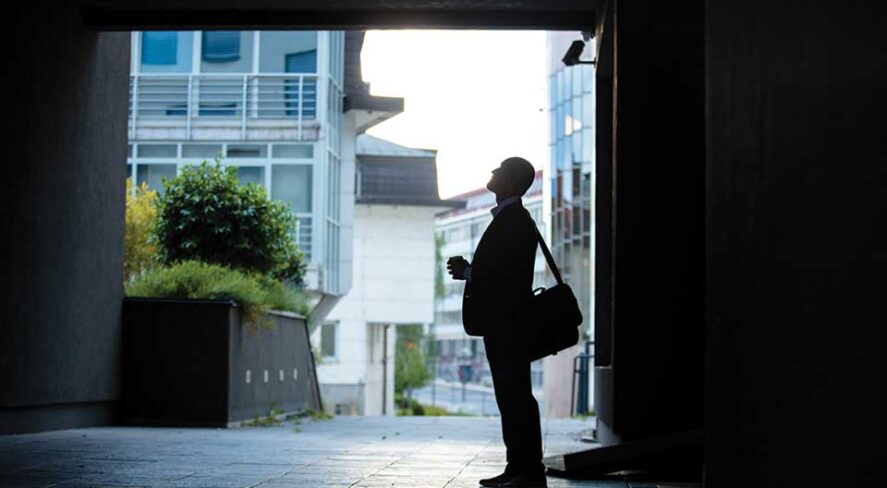Improving Visitor Management With Lighting Technologies

External illumination boosts accuracy of biometric solutions

Visitor management is a critical aspect of every physical security plan. Verifying the identity of patrons and guests before granting access to a facility is essential for maintaining a safe environment. Over the last decade, airports, government facilities, banks, data centers and other institutions have increasingly adopted contactless, biometric technology systems, such as facial and iris recognition. In fact, according to Cognitive Market Research, the global contactless biometric technology market size was estimated to be $48.2 billion in 2023 and is forecast to grow at a compound annual growth rate of 19% through 2030.
These technologies are attractive options as they offer a reliable, accurate and unintrusive means for identity validation. They are used to authenticate travelers going through custom checkpoints, verify security clearance prior to granting employees access to restricted areas, confirm when a high-paying patron is in the building so that staff can provide optimal customer service, and bar individuals who have violated company policies and are not allowed to enter the premises.
However, in order for biometric technologies that rely on a visual scan to work effectively, it is essential that security cameras are optimized to capture the highest quality video. This is where infrared (IR) and white light are important.
How Facial and Iris Recognition Work
Facial recognition analytics use video cameras to scan images, then use algorithms to map faces and detect unique features. This information is translated into hundreds of data points to replicate the geometry of a person’s face. The face print is then used as a reference point for employees or visitors who seek to enter a building.
Studies from the National Institute of Standards and Technology and other organizations have analyzed the impact of lighting on facial recognition performance and found that variation in brightness and direction of lighting in reference images can negatively affect detection rates.
In scenarios where surveillance cameras are placed outdoors at various entry points, changes in lighting conditions are inevitable. Capturing clear video in low or no light scenarios is extremely challenging. Even high-quality cameras struggle without consistent, adequate illumination.
Iris recognition works similarly to facial recognition in that a camera scans or photographs a person’s unique iris structure, creates an iris template, and stores it for future comparison. In order to capture the specific attributes of the iris structure, however, the system needs both IR lighting and a camera that is sensitive to IR.
Lighting for Increased Detection Accuracy
To increase detection accuracy for facial and iris recognition applications, security professionals can install external IR and white light illuminators. Built-in LEDs on cameras, while convenient, have limitations. Typically, camera LEDs emit light up to 150 feet and cover a 30-degree field of view, despite the cameras themselves typically having a field of view of 90 degrees or more. The coverage gap creates hotspots in the image. Built-in LEDs can also generate heat, which, over the long term, degrades the camera lens. The heat might also attract bugs, which can block the camera’s field of view.
In contrast, external lighting solutions, such as IR and white light illuminators, offer expanded emission ranges extending to hundreds of feet. Many illuminators emit light at four times the standard range of cameras with integrated LEDs. External illuminators also offer greater angle flexibility, with common options available in 30, 60 and 120 degrees, to name a few options.
Ultimately, the value of external lighting solutions is that they are designed to create evenly illuminated scenes, which is essential for video-based biometric systems. For example, when IR illuminators are paired with specialty cameras, the system yields sharp, crisp and detailed images for iris recognition. Deploying white light illuminators alongside cameras for facial recognition, meanwhile, minimizes the appearance of shadows, increases the visibility of facial features, and enables greater accuracy in color representation.
Conclusion
Facial and iris recognition systems for employee and visitor management will continue to see steady deployment in the years ahead. However, the accuracy of these systems depends on the accuracy of the images they read. Security teams can increase detection rates and reduce the risk of false positives by optimizing video capture capabilities. This starts with investing in external IR and white light technologies designed to enhance the performance of video-based biometric technologies.
By improving image detail and video capture, lighting leads to more precise detection and actionable data that allows for more informed decision making, all of which increases the overall functionality, performance and return on investment of facial and iris recognition systems.
